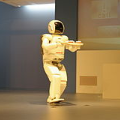Ground robots always get collision in that only if they get close to the obstacles, can they sense the danger and take actions, which is usually too late to avoid the crash, causing severe damage to the robots. To address this issue, we present collaboration of aerial and ground robots in recognition of feasible region. Taking the aerial robots' advantages of having large scale variance of view points of the same route which the ground robots is on, the collaboration work provides global information of road segmentation for the ground robot, thus enabling it to obtain feasible region and adjust its pose ahead of time. Under normal circumstance, the transformation between these two devices can be obtained by GPS yet with much error, directly causing inferior influence on recognition of feasible region. Thereby, we utilize the state-of-the-art research achievements in matching heterogeneous sensor measurements called deep phase correlation network(DPCN), which has excellent performance on heterogeneous mapping, to refine the transformation. The network is light-weighted and promising for better generalization. We use Aero-Ground dataset which consists of heterogeneous sensor images and aerial road segmentation images. The results show that our collaborative system has great accuracy, speed and stability.
翻译:地面机器人只有在接近障碍物时才会碰撞,他们才能感觉到危险并采取行动,通常为时过晚,无法避免坠机,给机器人造成严重的损害。为了解决这一问题,我们介绍空中和地面机器人的合作,以确认可行的区域。利用空中机器人在地面机器人所在的同一路线上具有大规模不同观点点的优势,合作工作为地面机器人提供了道路分割的全球信息,从而使其能够获得可行的区域并提前调整其面貌。在正常情况下,这两个装置之间的转换可以通过全球定位系统取得,但错误很多,直接对承认可行的区域造成低影响。结果显示,我们的合作系统具有很高的准确性、速度和稳定性。




